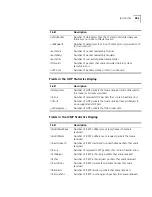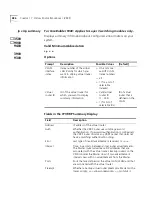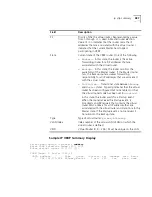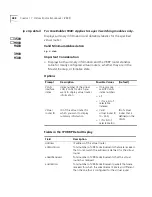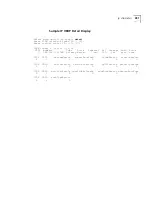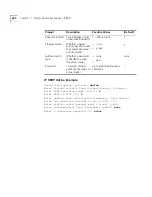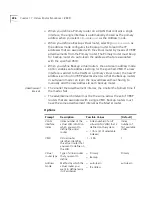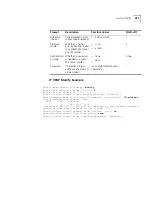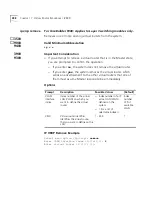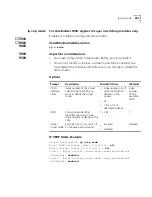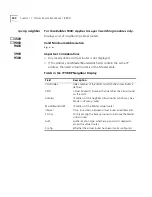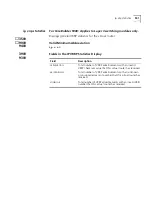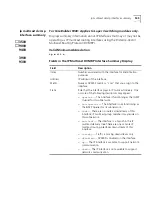
496
C
HAPTER
17: V
IRTUAL
R
OUTER
R
EDUNDANCY
(VRRP)
■
When you define a Primary router on a VLAN that contains a single
interface, the single interface is automatically chosen as the primary
address when you select
IP-address
as the Address mode.
■
When you define a Backup virtual router, selecting
auto-learn
as
the address mode configures the Backup router to learn the IP
addresses that are associated with the virtual router by means of VRRP
advertisements from the Primary router. The Primary router must be up
for backup routers to auto-learn the addresses that are associated
with the specified VRID.
■
When you define Backup virtual routers, the auto-learn address mode
option enables auto address learning for the specified VRID. If a new
interface is added to the VLAN on a primary virtual router, the new IP
address is sent out in VRRP advertisements so that the Backup routers
in auto-learn mode can learn the new address without having to
manually add the new address to each backup router.
Advertisement
Intervals
■
The smaller the advertisement interval, the smaller the failover time if
the master fails.
■
The advertisement interval must be the same across the set of VRRP
routers that are associated with a single VRID. Backup routers must
have the same advertisement interval as the Master router.
Options
Prompt
Description
Possible Values
[Default]
VLAN
interface
index
Index number of the
virtual LAN (VLAN) on
which you want to
define the virtual
router
■
Index number of an IP
virtual LAN (VLAN) that is
defined on the system.
■
? (for a list of selectable
indexes)
Index
number of
first available
VLAN
VRID
Virtual router
identifier. Identifies
the virtual router that
you want to define on
the LAN.
1 – 255
1
Virtual
router type
Type of virtual router
that you want to
define
■
Primary
■
Backup
Primary
Address
mode
Method by which the
virtual router you
want to define learns
its IP addresses
■
auto-learn
■
IP address
auto-learn
Summary of Contents for CoreBuilder 9000
Page 18: ......
Page 26: ...26 ABOUT THIS GUIDE ...
Page 27: ...I GETTING STARTED Chapter 1 Administration Overview Chapter 2 Command Summary ...
Page 28: ......
Page 64: ...64 CHAPTER 2 COMMAND SUMMARY ...
Page 65: ...II SYSTEM LEVEL FUNCTIONS Chapter 3 System Environment Chapter 4 Module Environment ...
Page 66: ......
Page 148: ......
Page 202: ......
Page 248: ...248 CHAPTER 8 FIBER DISTRIBUTED DATA INTERFACE FDDI ...
Page 250: ......
Page 320: ...320 CHAPTER 11 TRUNKS ...
Page 368: ...368 CHAPTER 14 VIRTUAL LANS VLANS ...
Page 394: ......
Page 502: ...502 CHAPTER 17 VIRTUAL ROUTER REDUNDANCY VRRP ...
Page 604: ...604 CHAPTER 19 OPEN SHORTEST PATH FIRST OSPF ...
Page 660: ...660 CHAPTER 20 IPX ...
Page 687: ...VII TRAFFIC POLICY Chapter 22 Quality of Service QoS and RSVP ...
Page 688: ......
Page 744: ...744 CHAPTER 22 QUALITY OF SERVICE QOS AND RSVP ...
Page 745: ...VIII MONITORING Chapter 23 Event Log Chapter 24 Roving Analysis ...
Page 746: ......
Page 754: ...754 CHAPTER 23 EVENT LOG ...
Page 764: ...764 CHAPTER 24 ROVING ANALYSIS ...
Page 765: ...IX REFERENCE Appendix A Technical Support ...
Page 766: ......
Page 772: ...772 APPENDIX A TECHNICAL SUPPORT ...
Page 784: ......


